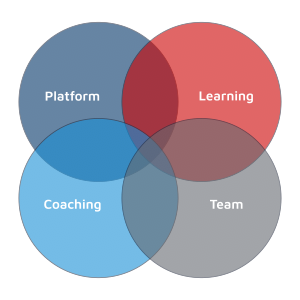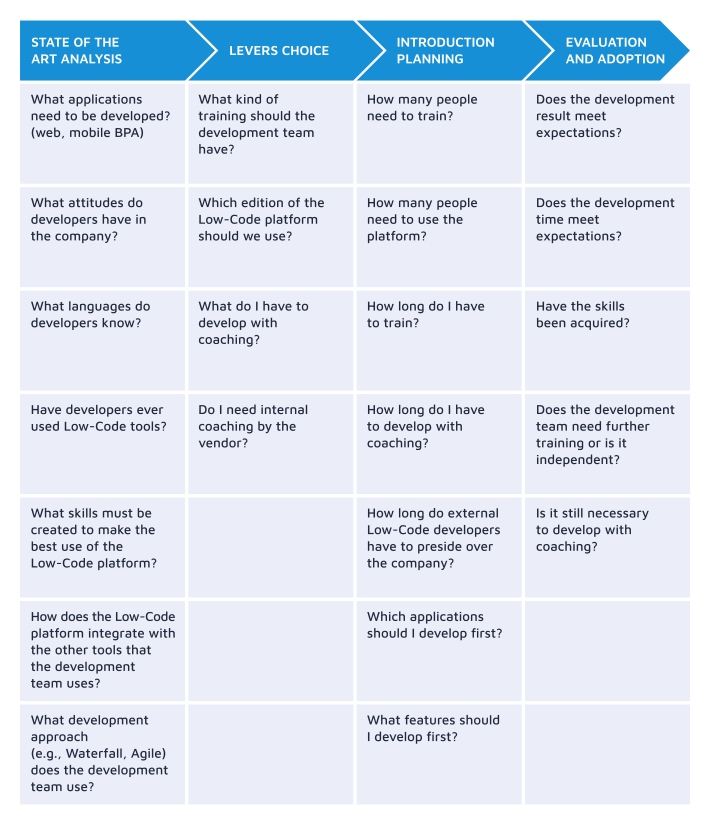How to create a customized strategy for introducing Low-Code in a company

Using a Low-Code platform such as WebRatio can lead to an increase in productivity of over 7 times[1], and having Low-Code developers increases the company’s value[2].
However, how can you bring Low-Code into the company, create the skills needed and start being productive immediately? Also, how can you avoid an increase in the technical debt already present in the company and decrease it thanks to Low-Code[3]?
Based on experience working with companies in introducing Low-Code technology, we can describe four fundamental levers on which the Low-Code adoption process is based:
-
The choice of the Low-Code platform
The main lever to start bringing the Low-Code to the company is certainly the choice of the platform to use. This evaluation is based on various elements: (a) current development needs (Which applications should I develop? Which development limits or criticalities do I want to overcome?); (b) future needs (What is my development roadmap?); (c) user profile (Is he/she a professional developer or a citizen developer?); (d) the cost model of the environment (Does it have a runtime cost? Does it cost per user? Per application? Per developer?); and (e) the risk of lock-in (Will I be able to modify the applications without using the platform?). Based on these elements, it is possible to evaluate the Low-Code environment best suited to the company’s needs.
-
The choice of people and the type of training
Another fundamental lever is the choice of people and their training, creating a development team with the individual characteristics best suited to fully exploit the potential of the Low-Code platform and planning an adequate training roadmap that allows you to not only acquire theoretical skills but also experiment continuously. For example, developers with fewer years of experience are more likely to use Low-Code tools because they are less linked to the knowledge of traditional programming languages, and, in general, developers who use Low-Code are more attentive to business needs because they are more involved in business dynamics. Therefore, it will be better to lean toward profiles with these characteristics when choosing resources.
-
A project startup with coaching
The third piece of the puzzle is the development with coaching, which comes in handy in the initial phase, especially during the formation of a development team that has never used Low-Code. It is possible to create (a) business pilots supported by a coach who can follow the entire life cycle of the first application and (b) some particularly complex features, extensions and integrations. In this way, the team that is adopting Low-Code is supported by experienced developers who can share their knowhow by creating a concrete project, and the production of digital solutions does not stop during the training period.
-
The internal team in the company
The last (but not least) of the four levers is the need for a constant team of Low-Code developers within the company—for reasons of continuity of adoption and growth of competence—to guarantee investment in the long term.
A personalized adoption strategy is based on the choice and use of these four levers and on the best mix between them because they are related to the state of the art in the company. It depends, for example, on the knowledge of Low-Code technology, the developers’ attitude, the applications to be developed and the urgency with which you want to start using Low-Code technology.

The phases of introduction of Low-Code in the company
The analysis of the state of the art in the company is the first step in understanding which levers to use, planning their use and, finally, evaluating the result and concluding the adoption of Low-Code technology.
Each of the phases corresponds to a series of questions whose answers are useful for the conclusion of the phase itself and in preparation for the next one.
Let’s look at a summary of the four phases and some examples of questions for each phase.

Customized strategies for different business development
Over the years we have met companies with different structures, organizations, teams and business development roadmaps.
Each vision, roadmap or business plan corresponds to a unique strategy for introducing Low-Code in the company because this technology can bring great results, but this is only true if its use is understood, integrated and aligned with the needs of the entire company, from the IT department to the top management
Discover the benefits that Low-Code technology brings to companies from all sectors >
Sources
[2] https://www.webratio.com/site/content/en/news-detail/low-code-developers-increase-business-value
[3] https://www.webratio.com/site/content/en/news-detail/technical-debt-low-code-solution
Latest Stories
Vibe Modeling: where AI meets Low-Code
From Cost Control to Continuous Innovation: The CIO’s New Balance
CIO priority for 2026: boosting productivity, including Low-Code
Tag
AllArtificial Intelligence - AI
BPA Development
BPM Software
Customer
Digital Transformation
Distribution & Retail
Energy & Utilities
Enterprise Applications
Finance & Insurance
IoT
LinkedIn Live
Low-code
Manufacturing
Mobile Development
Modernization
Partner
Shadow IT
Travel & Transportation
Web Development
WebRatio Platform